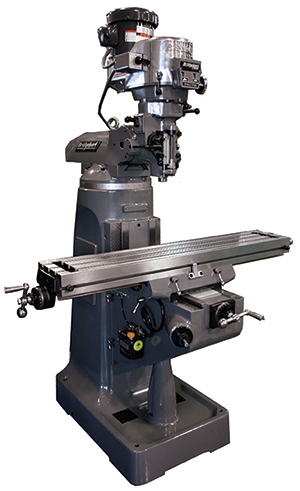Milling Machine
Make: Hardinge
Model: Bridgeport
Ace: Needed (Makerhub@georgefox.edu).
Location: Machine Shop
Description
The Bridgeport Series 1 Mill is a vertical mill used to mill various materials into desired shapes and sizes. It can also be used to perform special functions such as drilling, chamfering, reaming, fly cutting, and many more. Some examples of items made from mills are piston bore holes, valve plates, gears, and even your own tools. This is done by using a rotary cutter to remove material by advancing a cutter into a work piece in varying direction along three axes. Milling covers a wide variety of different operations and machines, on scales from small individual parts to large, heavy-duty gang milling operations. It is one of the most commonly used processes for machining custom parts to precise tolerances. The video below shows a part being machined by a CNC mill which is a computer driven mill, but still demonstrates the milling process.
Documentation
Terminology
- Spindle - The rotating shaft, driven by the motor, that holds the cutting tools.
- Quill - The part of the vertical milling machine that raises and lowers cutting tools held in the spindle.
- Quill Handle - The long handle on the right side of the machine that raises and lowers the quill.
- Endmill - A common machining tool having cutting teeth on the end of a cylindrical shank and usually spiral blades on the lateral surface. Because of this geometry it can cut in any direction.
- Facing - The process of cutting a flat surface perpendicular to the axes of the milling cutter. Often this is done on the initial piece of raw stock as the first step in the milling process.
- Deburring - To neaten and smooth the rough edges or ridges of a part after it has been machined.
- Edge finding - The process of using an edge finder to align the coordinate system of the mill with the corner of your part.
- Collet - A device that forms a collar around an object to be held and exerts a strong clamping force on the object when it is tightened. On the mill the collet is attached to the spindle and is used to hold cutting tools in place.
User Manual
Training
Overview
Insert Text
Demonstration
For the demonstration, you will face a piece of aluminum stock, drill a hole in the center, ream the hole, and deburr all of the edges. Reference the video below to see what this should look like.
General Procedure
This video contains specific information for using the Mills in the Maker Hub as well as a basic overview of what will be expected in your live demonstration.
Note that the tool changing system has been upgraded since this video was made. To insert a cutting tool under the new system, push the tool upwards into the collet with one hand and then push quill handle up with the other to compress the spring above the collet. Pushing up on the quill handle will allow the the tool to slide up into the collet and the tool will lock in place once the handle is lowered. A decent amount of force is required to compress the spring so don't be afraid to push hard. To release the tool, hold it in one hand while pushing up on the quill handle and then pull it out once the spring is compressed.
Safety
- General shop protocol is important when using the mill. Long hair, long sleeves, jewelry, gloves, and lanyards are all risks to be wrapped up by the spindle and should not be worn.
- Always make sure that there is plenty of space between
Certification
Troubleshooting
I do what i want
Maintenance
General maintenance
This machine requires minimal maintenance but like all the other machines in the Maker Hub it is important to clean the machine of metal chips and any other debris after each use. Anything more advanced is taken care of by Justin.
